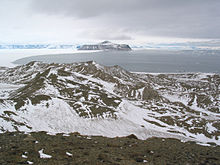- Seymour Island
-
Seymour Island
A view from Seymour IslandGeography Location Antarctica Coordinates 64°14′S, 56°37′W Country Demographics Population 0 Additional information Administered under the Antarctic Treaty System Seymour Island is an island in the chain of 16 major islands around the tip of the Graham Land on the Antarctic Peninsula. Graham Land is closer to continental land mass than any other part of that Antarctica.[1] It lies within the section of the island chain that resides off the west side of the peninsula's northernmost tip. Within that section, it lies slightly to the north of Snow Hill Island and just of east of the larger key, James Ross Island, and its smaller, neighboring island, Vega Island.
Seymour Island is sometimes called Marambio Island or Seymour-Marambio Island, taking its resident Argentine base as its namesake (see section, Base Antárctica Marambio, below).
Contents
Base Antárctica Marambio
Main article: Marambio BaseLocated in the island is the Marambio Base which is the main Argentine base in Antarctica operating an airfield ( ICAO SAWB ) for wheeled landing the whole year.[2] In winter the base has an average of 55 crew members, but in summer the population of the base can grow to 180.[3]
Climate
The average temperatures on Seymour Island, as measured at Base Antárctica Marambio, are 1 °C (33.8 °F) during the summer and −21 °C (−5.8 °F) during the winter. In the wintertime, however, strong winds can lower the wind chill temperature as low as −60 °C (−76 °F).
Paleontological significance
The rocks making up Seymour Island date mainly from the Late Cretaceous to the Eocene. Successively younger rock formations found on the island are the López de Bertodano Formation (Cretaceous to early Paleocene) Sobral Formation and Cross Valley Formation (Paleocene) and La Meseta Formation (Eocene).
In November 1882, when Norwegian Captain, Carl Anton Larsen landed his ship, the Jason, on Seymour Island, he returned with more than maps of the territory, he found fossils of long-extinct species. Interestingly, Larsen's trip aboard the Jason was significantly more successful than his Swedish Antarctic Expedition journey between 1901 and 1904. During that trip, his ship, the Antarctic, was crushed and sunk by icebergs, and he and his crew were forced to weather fourteen months on the neighboring Snow Hill Island, surviving on penguins and seals. Ever since his voyage on the Jason, the island has been the subject of paleontological study.
Seymour Island has been the site of much study of the Eocene period of climatic cooling, a process that culminated in the initiation of Antarctic glaciation. Studies of the fine fraction carbonate from sites in the Southern Ocean suggest that, rather than a monotonic decrease in temperature over the Eocene period, the middle of the epoch was punctuated by a brief duration of warming (Bohaty and Zachos, 2003).[4]
Seymour Island has been a site of study of many fossils from this particular part of the Eocene period, during which there was a more flourishing ecosystem with diverse biota as a result of the warmer climate. A diverse array of fossilized species have been studied on the Island, including extinct penguin species (such as Palaeeudyptes klekowskii and Archaeospheniscus wimani), various species in the bivalvia class and various types of flora and fauna.[4]
A fossil marsupial of the extinct family Polydolopidae was found on Seymour Island in 1982.[5] This was the first evidence of land mammals having lived in Antarctica. Further fossils have subsequently been found, including members of the marsupial orders Didelphimorphia (opossum) and Microbiotheria,[6] as well as ungulates and a member of the enigmatic extinct order Gondwanatheria, possibly Sudamerica ameghinoi.[7][8][9]
See also
- Composite Antarctic Gazetteer
- List of Antarctic islands south of 60° S
- SCAR
- Territorial claims in Antarctica
References
- ^ ESA Science & Technology: Graham Land
- ^ Antarctic facilities – comnap.aq
- ^ official page
- ^ a b Middle Eocene Warming On Seymour Island, Antarctica: Continental Shelf Paleotemperatures Recorded In Molluscan Carbonates
- ^ Woodburne, Michael O.; Zinsmeister, William J. (Oct 1982). "Fossil Land Mammal from Antarctica". Science 218 (4569): 284–286. doi:10.1126/science.218.4569.284. PMID 17838631. http://www.sciencemag.org/cgi/content/abstract/218/4569/284. Retrieved 2009-01-17.
- ^ Goin, Francisco J.; et al. (Dec 1999). "New Discoveries of "Opposum-Like" Marsupials from Antarctica (Seymour Island, Medial Eocene)". Journal of Mammalian Evolution 6 (4): 335–365. doi:10.1023/A:1027357927460. http://www.springerlink.com/content/h5r16469kqr06560/. Retrieved 2009-01-17.
- ^ Reguero, Marcelo A.; Sergio A. Marenssi and Sergio N. Santillana (May 2002). "Antarctic Peninsula and South America (Patagonia) Paleogene terrestrial faunas and environments: biogeographic relationships". Palaeogeography, Palaeoclimatology, Palaeoecology 179 (3–4): 189–210. doi:10.1016/S0031-0182(01)00417-5.
- ^ Mills, William James. Exploring Polar Frontiers: A Historical Encyclopedia, ABC-CLIO, 2003. ISBN 1576074226, 9781576074220
- ^ Goin, F.J.; Reguero, M.A.; Pascual, R.; von Koenigswald, W.; Woodburne, M.O.; Case, J.A.; Marenssi, S.A.; Vieytes, C. et al. (2006). "First gondwanatherian mammal from Antarctica". Geological Society, London, Special Publications 258: 135–144. doi:10.1144/GSL.SP.2006.258.01.10.
External links
Categories:- Natural history of Antarctica
- Paleontological sites of Antarctica
- Argentine Antarctica
- British Antarctic Territory
- Chilean Antarctica
- Islands of the James Ross Island group
Wikimedia Foundation. 2010.

